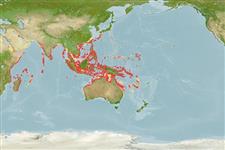Common names from other countries
>
Syngnathiformes (Pipefishes and seahorses) >
Centriscidae (Snipefishes and shrimpfishes) > Centriscinae
Etymology: Aeoliscus: Derived from Aeolius, region from Asia Minor and Aeolus, the Greek god of winds (Ref. 45335).
More on author: Günther.
Environment: milieu / climate zone / depth range / distribution range
Ecologia
marinhas associadas(os) a recifes; intervalo de profundidade 2 - 42 m (Ref. 90102). Tropical; 32°N - 32°S, 38°E - 170°E
Indo-West Pacific: Tanzania (Ref. 51015) and Seychelles (Ref. 1623); then from southern Japan to New South Wales, Australia eastward to Vanuatu.
Tamanho / Peso / Idade
Maturity: Lm ? range ? - ? cm
Max length : 15.0 cm TL macho/indeterminado; (Ref. 1602)
Espinhos dorsais (total) : 3; Raios dorsais moles (total) : 9 - 10; Espinhos anais: 0; Raios anais moles: 12. Recognized by hinged part of dorsal fin spine. Variable in color with habitat. Greenish-yellow with diffused stripe when in seagrass environment. Pale with black stripe when found on open substrate with white sand or rubble (Ref. 48635).
Form schools among the spines of Diadema or staghorn corals, and feed on minute crustaceans in the zooplankton. Remarkable for their strange body shape and swimming habit: the body is encased in an armor of thin, transparent plates; they swim in synchronized groups, each fish in a vertical position with the snout pointing downwards.
Life cycle and mating behavior
Maturities | Reprodução | Spawnings | Egg(s) | Fecundities | Larvas
Myers, R.F., 1991. Micronesian reef fishes. Second Ed. Coral Graphics, Barrigada, Guam. 298 p. (Ref. 1602)
Categoria na Lista Vermelha da IUCN (Ref. 130435)
CITES (Ref. 128078)
Not Evaluated
Ameaça para o homem
Harmless
Utilização humana
Pescarias: sem interesse; Aquário: Espécies comerciais
Ferramentas
Relatórios especiais
Descarregue XML
Fontes da internet
Estimates based on models
Preferred temperature (Ref.
115969): 25.2 - 29.3, mean 28.6 (based on 2830 cells).
Phylogenetic diversity index (Ref.
82804): PD
50 = 0.7502 [Uniqueness, from 0.5 = low to 2.0 = high].
Bayesian length-weight: a=0.00282 (0.00106 - 0.00750), b=3.10 (2.86 - 3.34), in cm Total Length, based on LWR estimates for this (Sub)family-body shape (Ref.
93245).
Nível Trófico (Ref.
69278): 3.5 ±0.48 se; based on food items.
Resiliência (Ref.
120179): Elevada, tempo mínimo de duplicação da população menor que 15 meses (Preliminary K or Fecundity.).
Fishing Vulnerability (Ref.
59153): Low vulnerability (10 of 100).
